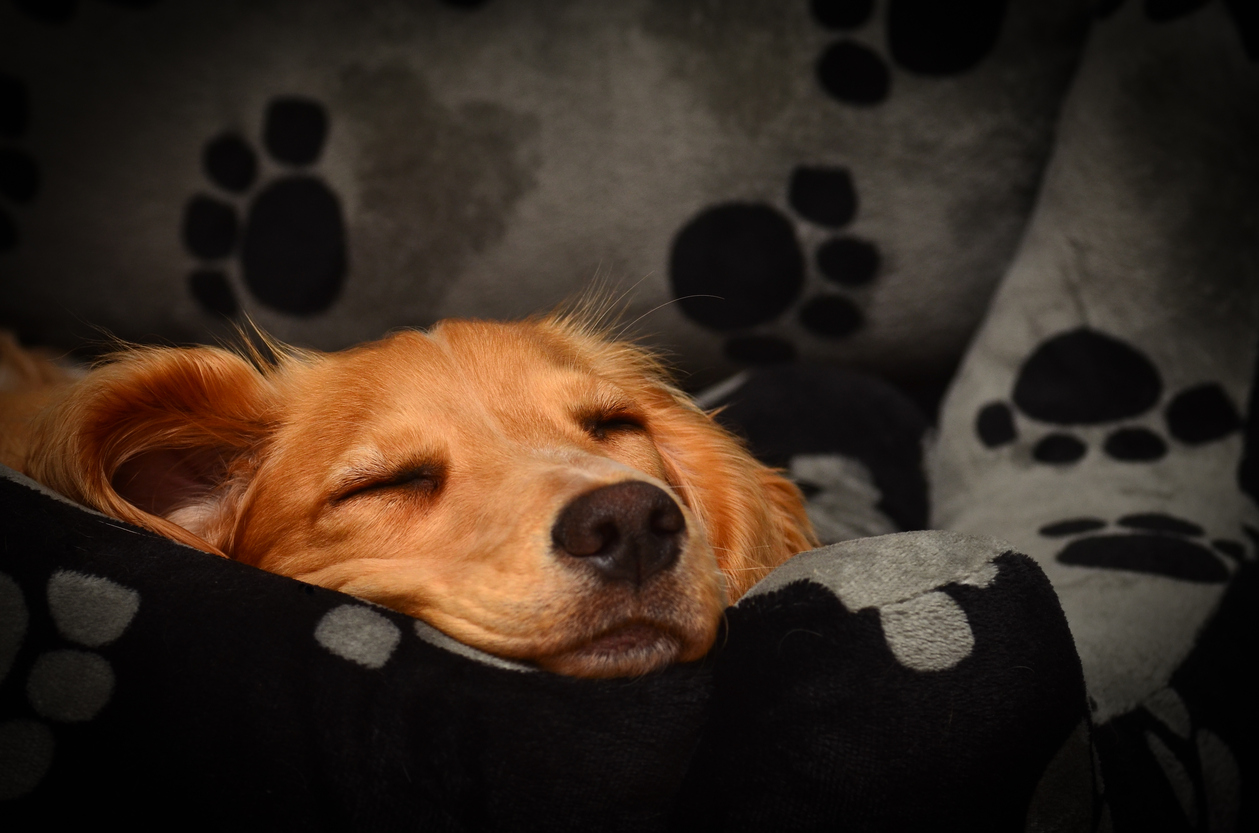
Dogs are pack animals. When your family adopts a dog, you become members of his or her “pack.” A common behavior of pack animals is that they sleep together for protection and bonding. Knowing this, it makes sense that your dog wants to be as close to you as possible throughout the night. While some pet owners enjoy the closeness, others don’t want to share precious pillow space with their four-legged friends.
For some pet owners, allergies prohibit this arrangement. For others, the idea of dog hair, dander, or (heaven forbid!) fleas is enough to cause nightly nightmares. Some dogs are too big to share your space, and some are annoying—always trying to sleep on your head, or stretching out to push you near the bed’s edge. Frankly, some people just want the bed a sacred place where they can stretch out, move, and get up during the night.
Regardless of your reason for restricting your dog’s sleeping arrangements, you can help him or her understand where the appropriate sleeping space is. You may want to start with crate training and use the crate as your dog’s primary bed. If you desire, you can also give your dog bedding to use in the bedroom or in other rooms of the house.
Crate Training
Dogs naturally seek a small, cozy space in which to curl up and sleep. These den-like spaces provide safety and security in the dog’s mind. A dog crate simulates a den that a dog (or any canine species) would create in the wild. It should be just big enough for the dog to stand, turn, and lie down in—so get a crate that fits your dog. You should introduce your dog to the crate in a non-threatening manner. Insert bedding and toss in a few scrumptious
CANIDAE® dog treats. Leave the door open and let your dog explore the crate.
When your dog starts to go to the crate to lie down, shut the door for short periods of time—start with a half an hour, then let him or her out. Next time, extend to an hour…working up to eight-hour shifts. The crate can also be used during house training, but be careful with puppies that need to eliminate during the night. An adult dog should be able to sleep through the night without going outside, but dogs mature at different rates. During the first year, carefully monitor your dog’s patterns for urinating and defecating.
When your dog is trained, bring the crate into the bedroom and use it at night. If your dog gets restless or whiney, cover the crate with a blanket for darkness, but make sure your dog is getting sufficient air.
Fancy Beds
If your dog can be trusted not to climb under your blankets at night, he or she can sleep on an open bed. Start by placing your dog on the dog bed and have him or her do a down/stay on the bed. Keep your dog on the bed for short periods and release. Teach your dog to “go to bed” and stay firm with your command. Do not allow your dog to visit you in bed, or he or she will become very confused.
Teaching your dog to sleep in his or her own bed requires a mastery of the basic commands mentioned above, like down/stay. For further reading on training your dog, read our article on, “
7 Basic Commands Every Dog Should Know.”
 Dogs are pack animals. When your family adopts a dog, you become members of his or her “pack.” A common behavior of pack animals is that they sleep together for protection and bonding. Knowing this, it makes sense that your dog wants to be as close to you as possible throughout the night. While some pet owners enjoy the closeness, others don’t want to share precious pillow space with their four-legged friends.
For some pet owners, allergies prohibit this arrangement. For others, the idea of dog hair, dander, or (heaven forbid!) fleas is enough to cause nightly nightmares. Some dogs are too big to share your space, and some are annoying—always trying to sleep on your head, or stretching out to push you near the bed’s edge. Frankly, some people just want the bed a sacred place where they can stretch out, move, and get up during the night.
Regardless of your reason for restricting your dog’s sleeping arrangements, you can help him or her understand where the appropriate sleeping space is. You may want to start with crate training and use the crate as your dog’s primary bed. If you desire, you can also give your dog bedding to use in the bedroom or in other rooms of the house.
Crate Training
Dogs naturally seek a small, cozy space in which to curl up and sleep. These den-like spaces provide safety and security in the dog’s mind. A dog crate simulates a den that a dog (or any canine species) would create in the wild. It should be just big enough for the dog to stand, turn, and lie down in—so get a crate that fits your dog. You should introduce your dog to the crate in a non-threatening manner. Insert bedding and toss in a few scrumptious CANIDAE® dog treats. Leave the door open and let your dog explore the crate.
When your dog starts to go to the crate to lie down, shut the door for short periods of time—start with a half an hour, then let him or her out. Next time, extend to an hour…working up to eight-hour shifts. The crate can also be used during house training, but be careful with puppies that need to eliminate during the night. An adult dog should be able to sleep through the night without going outside, but dogs mature at different rates. During the first year, carefully monitor your dog’s patterns for urinating and defecating.
When your dog is trained, bring the crate into the bedroom and use it at night. If your dog gets restless or whiney, cover the crate with a blanket for darkness, but make sure your dog is getting sufficient air.
Fancy Beds
If your dog can be trusted not to climb under your blankets at night, he or she can sleep on an open bed. Start by placing your dog on the dog bed and have him or her do a down/stay on the bed. Keep your dog on the bed for short periods and release. Teach your dog to “go to bed” and stay firm with your command. Do not allow your dog to visit you in bed, or he or she will become very confused.
Teaching your dog to sleep in his or her own bed requires a mastery of the basic commands mentioned above, like down/stay. For further reading on training your dog, read our article on, “7 Basic Commands Every Dog Should Know.”
Dogs are pack animals. When your family adopts a dog, you become members of his or her “pack.” A common behavior of pack animals is that they sleep together for protection and bonding. Knowing this, it makes sense that your dog wants to be as close to you as possible throughout the night. While some pet owners enjoy the closeness, others don’t want to share precious pillow space with their four-legged friends.
For some pet owners, allergies prohibit this arrangement. For others, the idea of dog hair, dander, or (heaven forbid!) fleas is enough to cause nightly nightmares. Some dogs are too big to share your space, and some are annoying—always trying to sleep on your head, or stretching out to push you near the bed’s edge. Frankly, some people just want the bed a sacred place where they can stretch out, move, and get up during the night.
Regardless of your reason for restricting your dog’s sleeping arrangements, you can help him or her understand where the appropriate sleeping space is. You may want to start with crate training and use the crate as your dog’s primary bed. If you desire, you can also give your dog bedding to use in the bedroom or in other rooms of the house.
Crate Training
Dogs naturally seek a small, cozy space in which to curl up and sleep. These den-like spaces provide safety and security in the dog’s mind. A dog crate simulates a den that a dog (or any canine species) would create in the wild. It should be just big enough for the dog to stand, turn, and lie down in—so get a crate that fits your dog. You should introduce your dog to the crate in a non-threatening manner. Insert bedding and toss in a few scrumptious CANIDAE® dog treats. Leave the door open and let your dog explore the crate.
When your dog starts to go to the crate to lie down, shut the door for short periods of time—start with a half an hour, then let him or her out. Next time, extend to an hour…working up to eight-hour shifts. The crate can also be used during house training, but be careful with puppies that need to eliminate during the night. An adult dog should be able to sleep through the night without going outside, but dogs mature at different rates. During the first year, carefully monitor your dog’s patterns for urinating and defecating.
When your dog is trained, bring the crate into the bedroom and use it at night. If your dog gets restless or whiney, cover the crate with a blanket for darkness, but make sure your dog is getting sufficient air.
Fancy Beds
If your dog can be trusted not to climb under your blankets at night, he or she can sleep on an open bed. Start by placing your dog on the dog bed and have him or her do a down/stay on the bed. Keep your dog on the bed for short periods and release. Teach your dog to “go to bed” and stay firm with your command. Do not allow your dog to visit you in bed, or he or she will become very confused.
Teaching your dog to sleep in his or her own bed requires a mastery of the basic commands mentioned above, like down/stay. For further reading on training your dog, read our article on, “7 Basic Commands Every Dog Should Know.”
